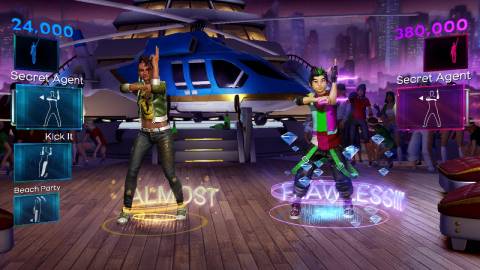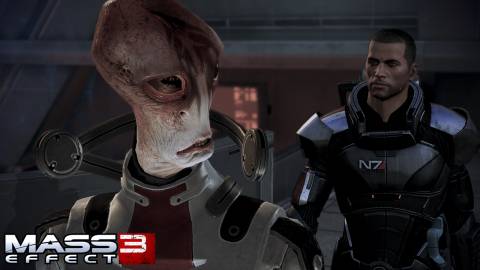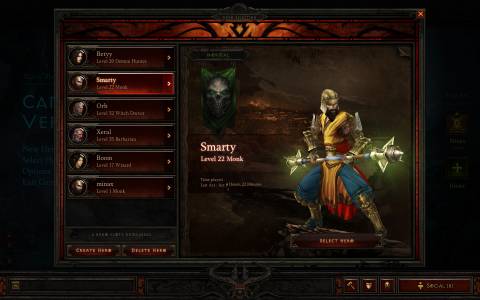The Kinect Lived up to its Potential Because it Never Had Any
By RedRocketWestie 3 Comments

This week's podcast (http://www.giantbomb.com/podcast/?podcast_id=347) had another brief discussion about how Kinect was a failure of its ideal implementation, and let everyone down based on its inability to deliver on its promise. The seeds of this idea first started germinating around the time Steel Battalion: Heavy Armor was getting diced to pieces, and now I'm finally ready to say it: the Kinect was never going to be what people wanted it to be (unless those people were Harmonix). And I'll tell you why.
What the Kinect set out to do
Taking away a physical controller and putting your whole body in its place, at a glance, sounds like a fantastic step in the direction of player immersion. After all, you're removing a layer of abstraction between what you're doing, and what's happening on the screen, right? Now, before we go any further, let me say that I will make excuses for vendor trash in the name of immersion. I will make excuses for inventory management in the name of immersion. I'll excuse a lot of dumb bullshit on the premise that it brings me further into the game world. But Kinect (and even most other motion control schemes) aren't really serving the purpose of immersion.
What motion controls are good for, and when they fail
Here's the thing: motion controls are great for lowering the barrier to entry. They present a more intuitive interface for someone who isn't accustomed to the abstraction that a controller provides. But for those of us who are comfortable with a controller, and who have cultivated the hand-eye coordination that makes the controller essentially an extension of our own bodies, pantomime is at least as much of an abstraction if not more. Dance games are a great success story for motion controls. It's a type of game that arguably suffered from the digital abstraction that Dance Dance Revolution and its ilk put in between dancing and gameplay. It's an action that makes sense with full body motion, and doesn't require a prop to feel natural. Similar things could be said for Double Fine Happy Action Theater or other "toy" style games, since they don't really rely on control at all.
The Wii struck a nice balance by allowing both analog and digital inputs, while at the same time providing a natural-feeling object to hold in one's hand. But the Kinect has neither a natural prop nor a digital input. Which means that, as good as it might feel to paint targets in Child of Eden, you still need to signal the digital action of firing. That's why a controller with analog sticks and buttons works so well. Some things are suited to analog control (controlling reticules, painting shapes) and some things are better done with digital inputs (choosing when to fire, selecting a color). Using an analog motion to signal a digital action doesn't work for two reasons:
- Detection -- the software needs to identify whether a motion matched an arbitrary "threshold" to signal the action, which could easily fail by being too sensitive or not sensitive enough
- Lag -- that detection process, even when it works, takes more time than the instantaneous response we expect from a controller
This disconnects the player's action from the expected response, and fundamentally hurts immersion. Now, instead of thinking about what I want to happen on screen (in the game world), I'm thinking about how to move my arm (in the real world) so that the game can understand me. I'm mentally translating, which constantly reminds me that I'm standing in my living room. And this disconnect is even more mind boggling in the context of Steel Battalion, which supplanted extremely intuitive digital controls for contrived hand motions. It's one thing when the game wants me to throw a punch in real life to throw a punch on screen. It's quite another when the game is asking you to swipe your hand left and right to look around. That's not how it works in real life, so why would you shoehorn in the motion control? But even in the case where you're miming real actions, you're not getting the physical feedback of actually grabbing something, so it's still going to take you out of the game.
What about Voice?

But motion controls are only half of the equation, right? What about voice commands? Well, we can easily apply the same reasoning to find out what voice commands are good for, and what they aren't good for. Voice commands are good for text entry. I use voice to search on my phone all the time, because it's inconvenient to type in that interface. The same could be said for the 360 (if you don't have a chat pad), provided the voice recognition is good enough on the console or server side. But games don't frequently ask you to input raw text, and when they do, it's rarely for things that would be in a dictionary (character name, etc.), so that's not really a practical application. So you're left with tactical commands and menu selections, both of which fall victim to the same shortcomings as the motion controls -- detection and lag. In the case of tactical commands (like squad management or Skyrim's shouts), it's a huge risk to count on the recognition in an action scenario, especially if the same thing could be mapped to a button or a pop-up menu. In the case of menu selections (like Mass Effect's dialogue wheel), it takes more time than using the controller, and it's unlikely you were using your hands for anything else. Once again, it's Dance Central that provides the cleanest example of how to use voice well, and even then, it's primarily useful because it allows you to avoid using the motion controls to navigate menus. With a controller, it'd be more or less the same.
Bottom line
I'm not a fan of motion controls. I think the steady flow of comparisons to Minority Report ignore the fact that movies try harder to imagine cool-looking future technology than actually useful implementations of future technology. I think the Wii does it well in a few cases (namely Wii Sports), and even then, it benefits greatly from the addition of buttons to punctuate your actions. Maybe I'm just an old man shaking my cane at those darn kids, but I just never saw the huge potential that everyone else did for motion controls in digital entertainment. There's just far too little that actually benefits from full-body analog control, and good control should be about removing barriers between intent and action, not shoehorning in new technology and awkward mechanics where they don't belong. Innovation is one thing, but there's a case to be made for "if it ain't broke."
The Kinect did absolutely as well as it ever could have. It wasn't ever going to be the revelatory game-changer that Peter Molyneux wanted it to be. It's good for dance games, and if that's not enough to justify the price of the device, I have to wonder what would have. What use cases were people dreaming up that wouldn't have ended up clunky and awkward?


Log in to comment